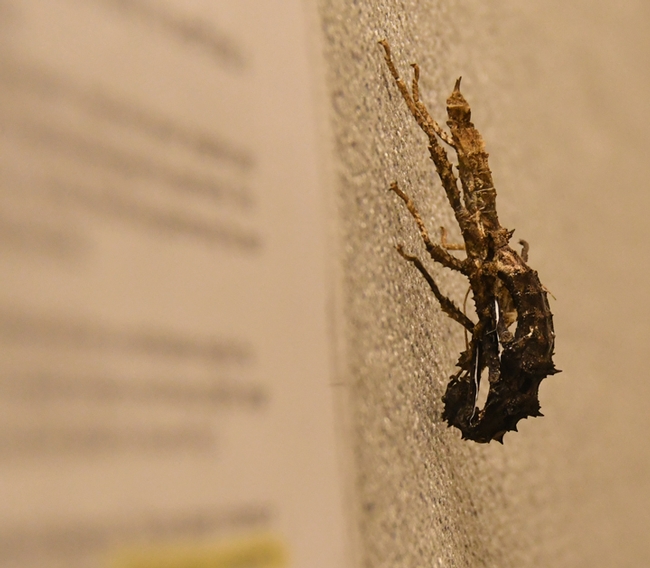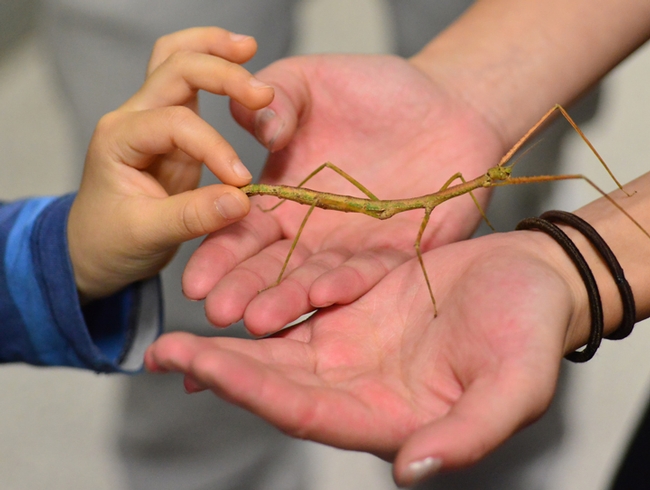- Author: Kathy Keatley Garvey
It's finals week at the University of California, Davis, and what a great opportunity to take time to de-stress...with bugs!
Wade Spencer, entomology student and associate at the Bohart Museum of Entomology, says that students studying in the UC Davis LGBTQUIA Resource Center at 397 Hutchison Drive on Tuesday, March 19, will be sharing their space with bugs, including Coco McFluffin, a Chaco golden knee tarantula that makes its home in the Bohart Museum of Entomology. The Bohart Museum, located in Room 1124 of the Academic Surge Building on Crocker Lane, houses a global collection of nearly eight million insect specimens--AND a live petting zoo of dozens of critters, ranging from Madagascar hissing cockroaches to stick insects to tarantulas.
Billed as the "Finals-Week Bug Meet-n-Greet De-Stressor," the event takes place from noon to 1 p.m. in partnership with LGBTQUIA and the Bohart Museum.
The visitors include Coco McFluffin, Lucy the Gooty and Captain Mar-Vel. Here's who's on tap:
- Thorny Walking Sticks: https://species.wikimedia.org/wiki/Aretaon
- Australian Stick Insects: https://en.wikipedia.org/wiki/Extatosoma_tiaratum
- Vietnamese Stick Insects: https://en.wikipedia.org/wiki/Medauroidea_extradentata
- Giant Cave Cockroaches: https://en.wikipedia.org/wiki/Blaberus_giganteus
- Chaco Golden Knee Tarantula (Coco McFluffin): https://en.wikipedia.org/wiki/Grammostola_pulchripes
- Western Black Widow (Karen): https://en.wikipedia.org/wiki/Latrodectus_hesperus
- Multi-colored Centipede (Sebastian): https://en.wikipedia.org/wiki/Scolopendra_polymorpha
- Desert Hairy Scorpion (Celeste): https://en.wikipedia.org/wiki/Hadrurus_arizonensis
- Asian Forest Scorpion (Scotty): https://en.wikipedia.org/wiki/Heterometrus
- African Yellow-Legged Burrowing Scorpion (yet unnamed): https://en.wikipedia.org/wiki/Opistophthalmus_glabrifrons
- Sapphire Gooty Tarantula (Lucy the Gooty): https://en.wikipedia.org/wiki/Poecilotheria_metallica#Description
- And...Wade Spencer's tiny Arizona burrowing scorpion (Captain Mar-Vel): "I don't know the scientific name of her yet and can't seem to find any info online. But she's cute and tiny!"
"It should be noted," Spencer said, "that the only venomous arthropod that will be up for touching/holding will be Coco."
Study on!
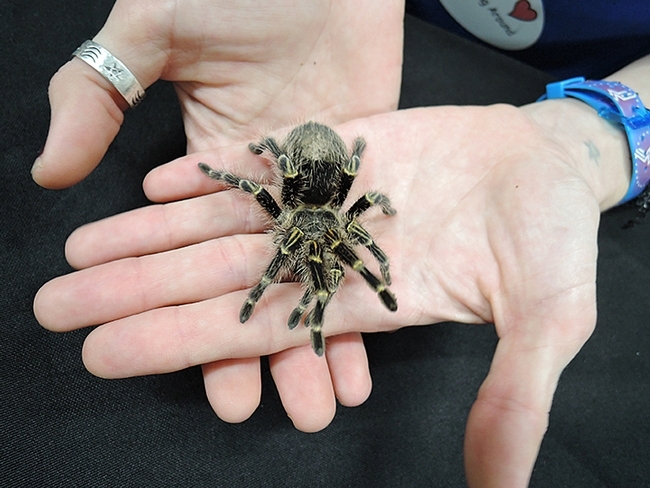
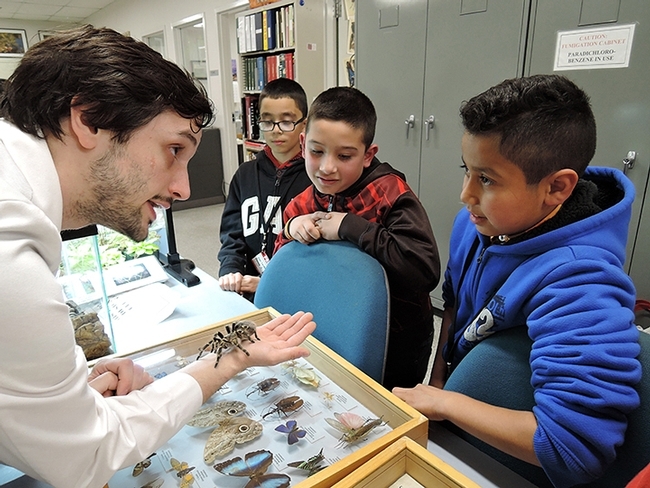
- Author: Kathy Keatley Garvey
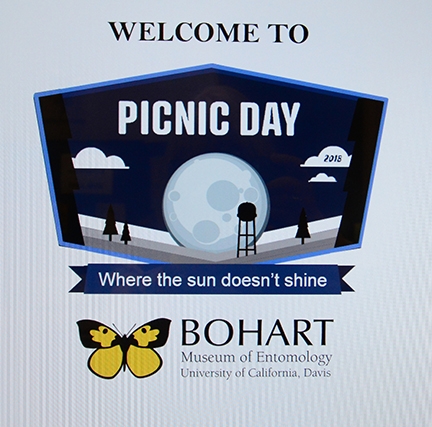
Who wouldn't, when you get an opportunity to pet a rose-haired tarantula named Snuggles, guide walking sticks "strolling" on your arm, or cradle a Madagascar hissing cockroach? Or marvel at the display of Platypsyllus castoris, an ectoparasite of beavers?
That's what awaited the 2000 visitors at the Bohart Museum of Entomology during the 104th annual UC Davis Picnic Day last Saturday, April 18.
Although the theme of the campuswide Picnic Day spanned "Where the Sun Shines," Bohart Museum officials focused on "Where the Sun Doesn't Shine." They highlighted nocturnal insects, cave-dwelling insects, and parasites, including a beetle, Platypsyllus castoris, found on the south end of a beaver.
Lynn Kimsey, director of the Bohart and professor of entomology at UC Davis, kept busy answering questions about the beaver display--a pelt, and a graphic of the beetle.
As Bohart Museum associate and undergraduate entomology student Wade Spencer said: "These beetles look like they are to fleas what halibut are to other fishes. Instead of the lateral compression fleas exhibit, Platyspyllus castoris are dorso-ventrally flattened, which only adds to their alien appearance. Their unique feeding and lodging preferences have given us so many good laughs, we wanted to make them the star of this year's picnic day event at the Bohart."
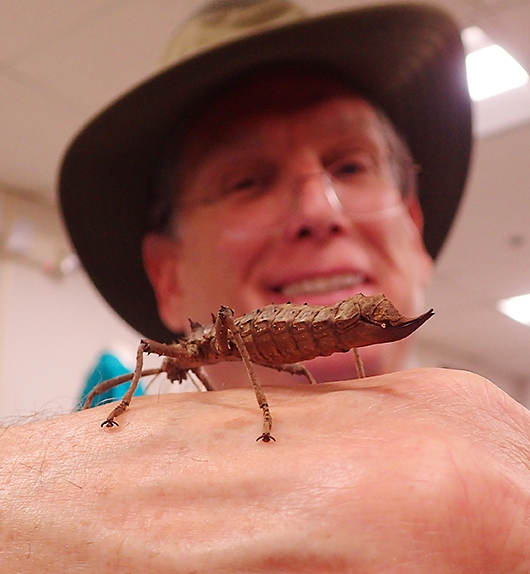
Entomologist Jeff Smith, who curates the butterfly and moth collection at the Bohart, kept busy encouraging visitors to get acquainted with Snuggles. They held him, petted him and photographed him. Little Teddy Owens, 2 of Davis, held by his mother, Dina, high-fived Snuggles.
Another display featured scorpions: graduate student Charlotte Herbert shone a black light on them to illustrate how they glow in the dark. All scorpions fluoresce in ultraviolet light.
Visitors also learned about bees in a display featuring sweat bees, leaf-cutting bees, mason bees, bumble bees, honey bees, sunflower bees, and carpenter bees, as well as Andrena and Melissodes anthophora.
The Bohart Museum houses a global collection of nearly eight million specimens. It is the home of the seventh largest insect collection in North America, and the California Insect Survey, a storehouse of the insect biodiversity. Special attractions include a “live” petting zoo, featuring Madagascar hissing cockroaches, walking sticks, praying mantids and tarantulas. The museum's gift shop, open year around, offers T-shirts, sweatshirts, books, jewelry, posters, insect-collecting equipment and insect-themed candy.
The Bohart Museum is open to the public from 9 a.m. to noon and 1 to 5 p.m. Mondays through Thursdays. It is closed to the public on Fridays, Saturdays and Sundays and on major holidays. Admission is free.
More information on the Bohart Museum is available by contacting (530) 752-0493 or emailing bmuseum@ucdavis.edu or Tabatha Yang at tabyang@ucdavis.edu.
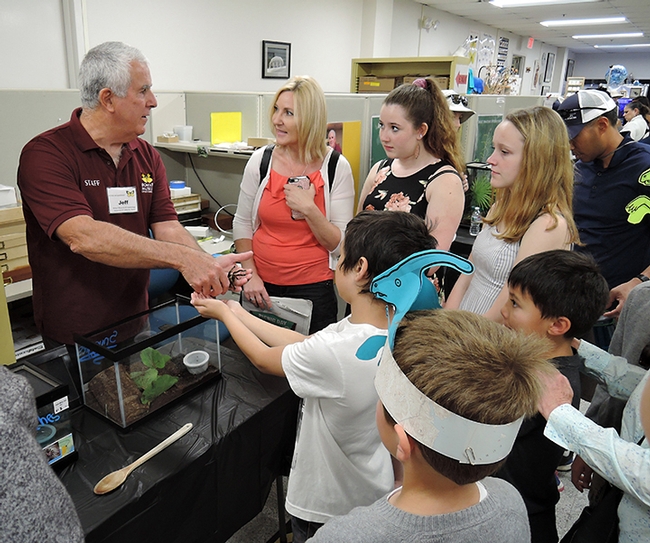

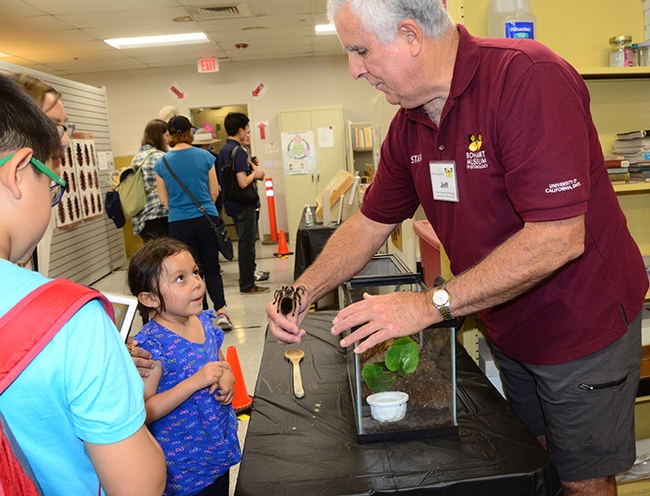
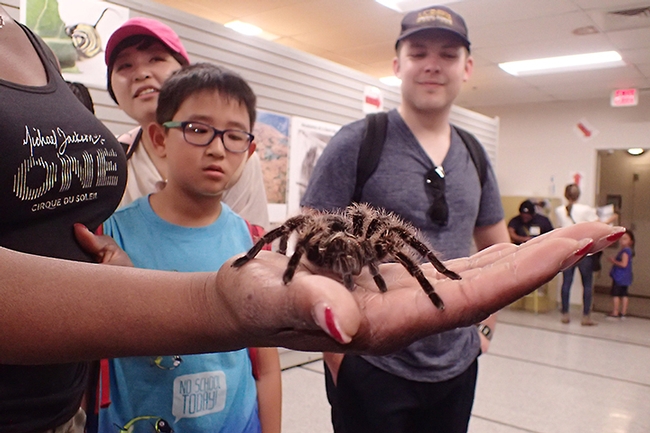
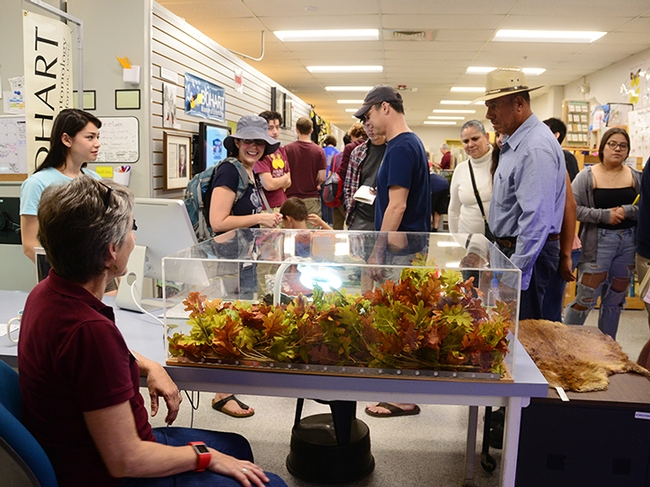
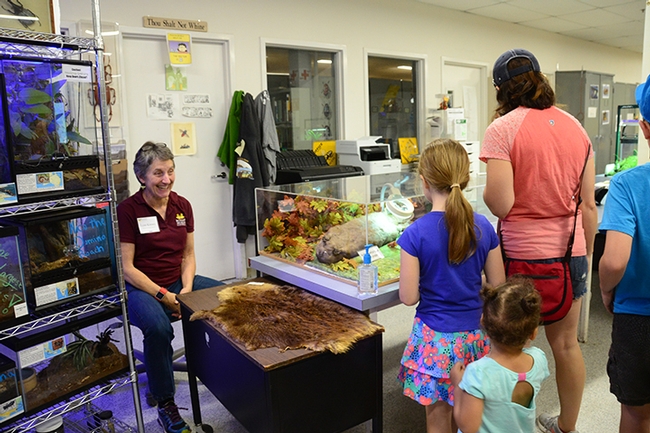
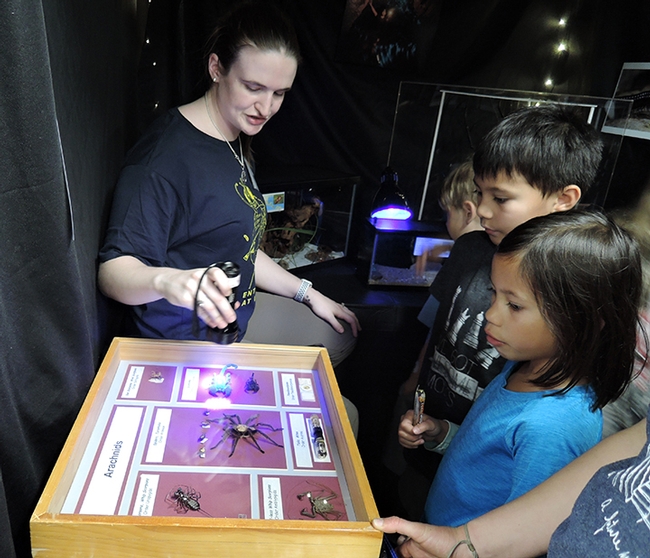
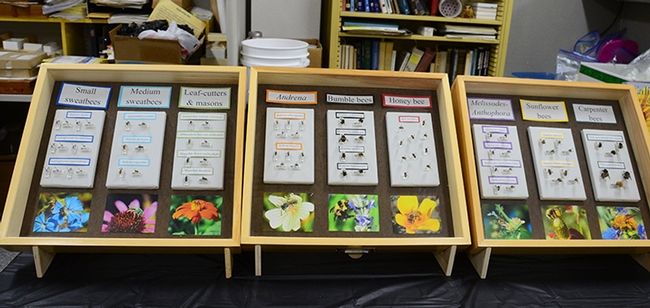
- Author: Kathy Keatley Garvey
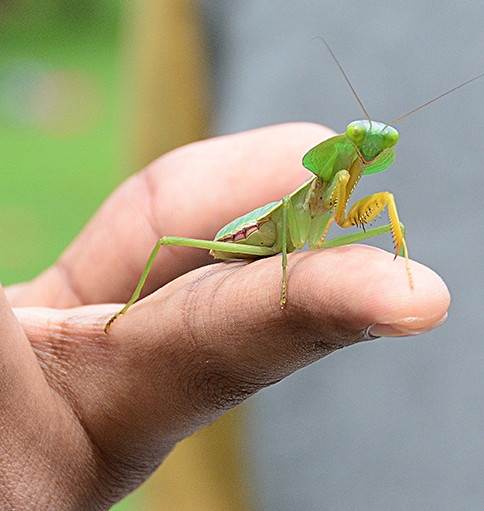
Well, UC Davis officials and the UC Davis Department of Entomology and Nematology did!
Yes!
All systems are "go" for the 104th annual UC Davis Picnic Day, an all-day event on Saturday, April 21 when scores of visitors, aka picnickers, will stroll the campus. It promises to be both educational and entertaining.
The UC Davis Picnic Day Committee offered a pre-view Thursday noon at the Quad.
Bohart Museum of Entomology representatives--Wade Spencer, Lohit Garikipati, and Diego Rivera, all UC Davis students and Bohart associates--kept busy answers questions about scorpions, stick insects and praying mantids.
Spencer displayed his desert hairy scorpion named Celeste. Okay, surprise, surprise! Celeste turned out to be a male, but his name remains Celeste.
Lohit Garikipati, an entomology student who rears praying mantids, came with his buddy, a Malaysian shield mantis. "What's that?" visitors asked, looking at the shield.
For a hour, the trio entertained the guests. Some expressed awe at Spencer casually holding a scorpion. "I've been handling scorpions since I was three," he said. "I've never been stung."
Rivera showed an Australian leaf walking stick insect that resembled a leaf. The crowd took turns holding and photographing it.
Now it's showtime!
On Saturday, April 21, during the campuswide Picnic Day, you can engage with insects at both Briggs Hall, which houses the Department of Entomology and Nematology administration and most of the faculty, and the Bohart Museum of Entomology, home of eight million insect specimens.
At Briggs Hall, located off Kleiber Hall Drive, activities will take place from 9 a.m. to 4 or 5 p.m. At the Bohart Museum of Entomology, located in Room 1124 of the Academic Surge Building on Crocker Lane, the open house is from 10 to 3 p.m.
Here's what's on tap at Briggs, either in front or inside the building:
- Entomology at UC Davis: Enter Briggs Hall and find a wide variety of entomology-themed displays, from classics, including insect forestry to recent additions, such as “Virtual Reality Bugs."
- Honey Tasting Booth: Extension apiculturist Elina Lastro Niño and her staff will operate the honey tasting booth, focusing on berry honeys. They will offer these honey varietals: blackberry, blueberry, raspberry, snowberry, almond and buckwheat.
- Maggot Art: Visitors will create maggot art by dipping a maggot into a water-based, non-toxic paint and position it on paper and let it crawl. Voila! Maggot art, suitable for framing
- Cockroach Races: Crowds can pick their favorite "roach athlete" and cheer it to victory
- Virtual Reality Bugs: Medical entomologist Geoffrey Attardo will set up a virtual reality system to enable people to view three dimensional models of insects. In VR, the models can be made to look life size, 40 feet tall or anywhere in between, he says. Here's the link that to view them in your web browser: https://skfb.ly/6xVru
- Bug Doctor: The Doctor Is In: Graduate students will identify insects and arachnids and answer questions
- IPM Booth: UC Statewide Integrated Pest Management Program professionals will discuss and answer questions about insect pests, beneficial insects and pest control. They will display their publications and live insects. In keeping with tradition, they will give away free lady beetles (lady bugs), to be released in gardens to devour aphids and other soft-bodied insects.
- Mosquito Abatement: Sacramento-Yolo Mosquito and Vector Control District professionals will staff a booth
- Dr. Death: Forensic entomologist Robert Kimsey will staff his traditional Dr. Death booth, inviting the visitors to ask questions and look through microscopes.
- Davis Fly Fishers: The anglers will demonstrate fly-tying techniques in Briggs 158
- Scavenger Hunt: Participants will search for and identify insects in a display of 10 drawers in Briggs 122.
- Insect Face Painting: Entomology Club members will face-paint bees, butterflies, lady beetles and other insects
- T-Shirt Sales: Visitors can take their pick or picks among insect-themed t-shirts (popular t-shirts include beetles and honey bees) Selection and prices are online at https://mkt.com/UCDavisEntGrad/
- Bake Sale: The Entomology Club will offer insect-themed baked goods.
- Strike Up the Band: Music composed by Michael Lewis Bollinger (Frank Zalom lab); cover songs possible. The band, dressed in insect costumes, will include Jackson Audley of the Steve Seybold lab, rhythm guitar; Yao Cai of the Joanna Chiu lab, drums; Christine Tabuloc of the Chiu lab, vocals; Zachary Griebenow of the Phil Ward lab, keyboard; Wei Lin of the Brian Johnson lab, bass; Jill Oberski of the Phil Ward lab, tenor saxophone; and Brendon Boudinot of the Phil Ward lab, bassist.
"The band will be setting up and warming up at 4," said Boudinot. "We'll start our set at 4:30, and wrap up at 5 or so. We are working on tightening up the set list--for now we have four songs. Expect some guitar and drum solos at the least!"
Bohart Museum
At the Bohart Museum, open from 10 a.m. to 3 p.m., the theme is "Where the Sun Doesn't Shine," a play on this year's Picnic Day theme of "Where the Sun Shines."
"We'll be highlighting nocturnal insects, cave dwelling insects, and yes, beaver butt beetles or Platypsyllus castoris, an ectoparasite on beavers, near their glands, wounds, and skin," said Tabatha Yang, education and outreach coordinator. " We will be holding insects as well."
The Bohart Museum will also showcase its live "petting zoo," comprised of Madagascar hissing cockroaches, walking sticks or stick insects, tarantulas and mantids. The museum also offers a year-around gift shop with T-shirts, jewelry, posters, books, insect nets and the like.
"Entomology at UC Davis" (122 Briggs) has been nominated for a special campus award under the category "At One With Nature." The Honey Tasting booth at Briggs has been nominated for a similar award under the category, “Hunger Fix.” Winners of the categories are determined by an Internet vote. (Access the link here to vote from 8 a.m. to 10 p.m. for your favorite exhibits on Picnic Day). The winners will be publicized on the Picnic Day website, Facebook, Twitter, Instagram, and Snapchat accounts after Picnic Day.
What's a picnic without bugs?
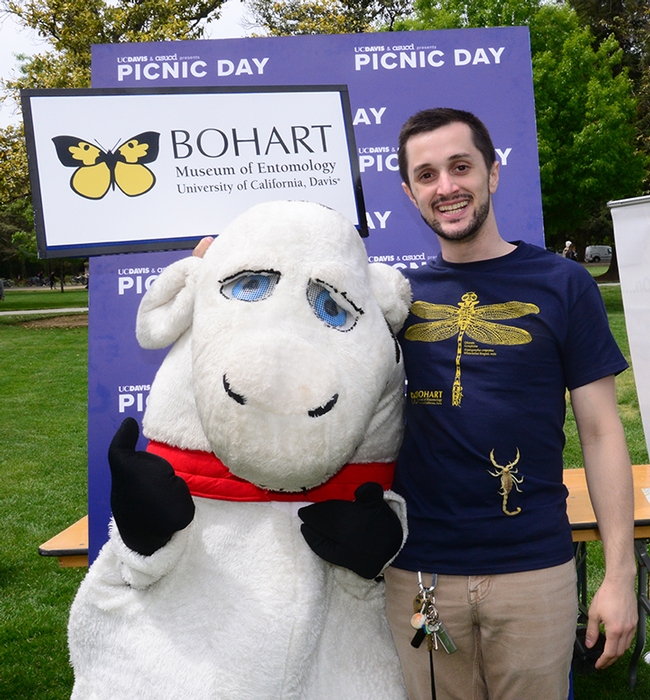
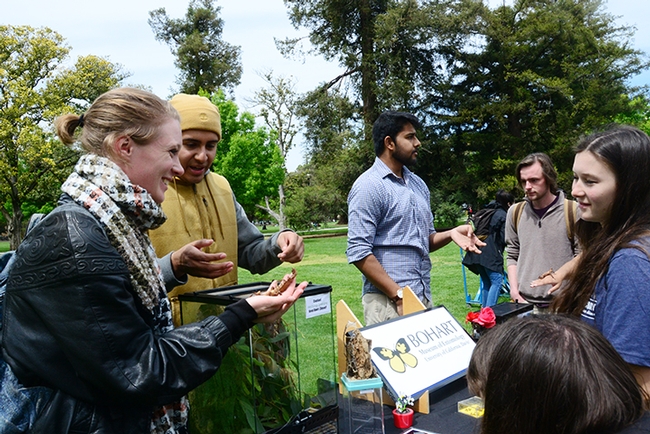
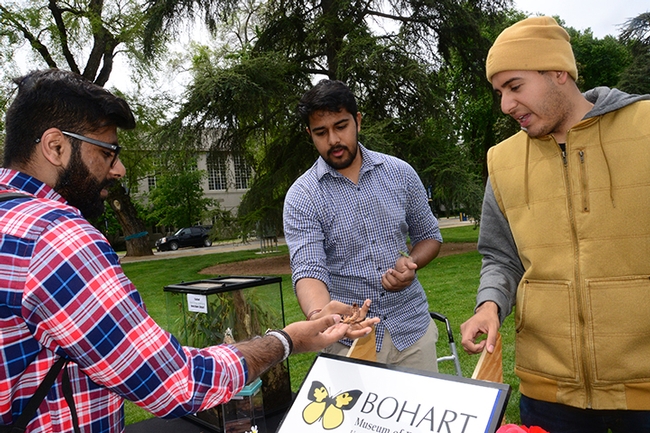
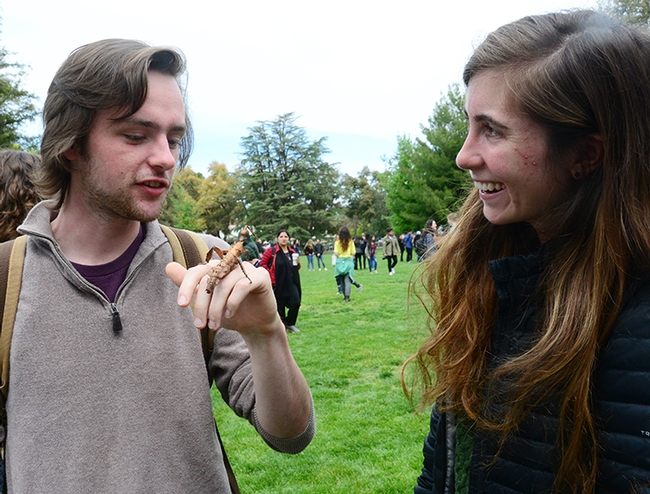
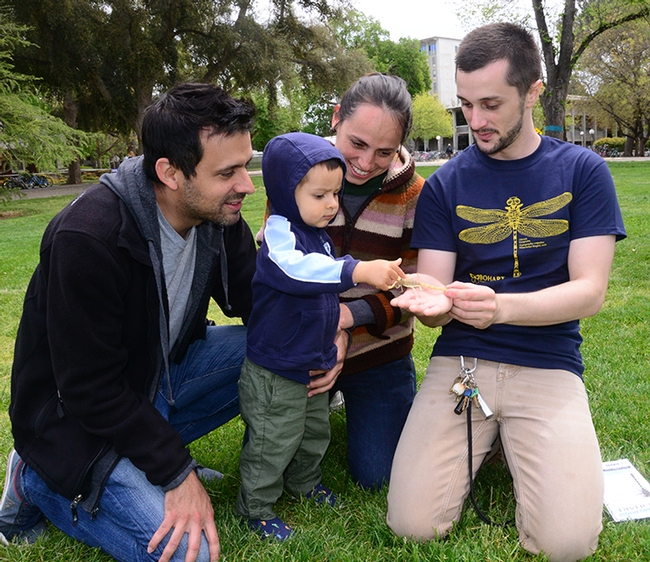
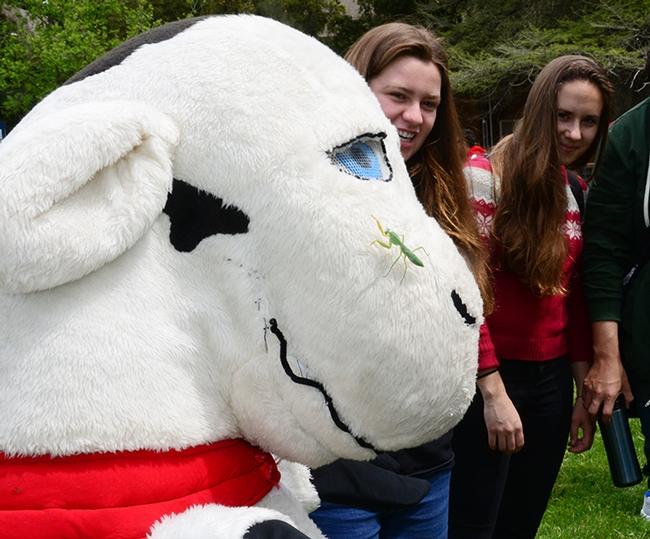
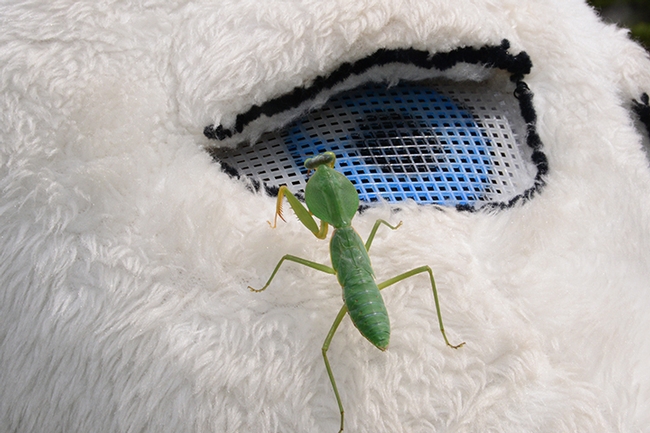
- Author: Kathy Keatley Garvey
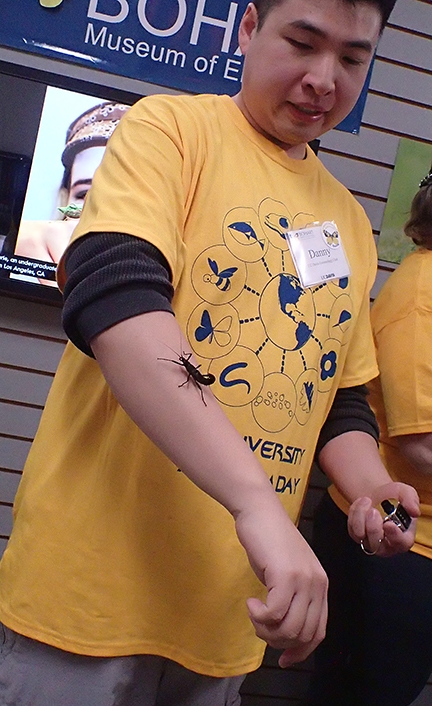
If you had asked that question at the Bohart Museum of Entomology open house at the seventh annual Biodiversity Museum Day last Saturday at the University of California, Davis, the Yellow Shirts would have been proud.
The Yellow Shirts were the volunteers--the insect enthusiasts who share their time, dedication and expertise.
Check out the photos and you can see and feel--and almost hear--the excitement.
- UC Davis student Danny Nguyen coaxing a walking stick to climb his arm.
- UC Davis student Diego Rivera showing Madagascar hissing cockroaches.
- UC Davis doctoral candidate Jessica Gillung encouraging questions from an inquisitive group of youngsters and adults.
- UC Davis entomology graduate Joel Hernandez displaying a walking stick or stick insect.
- UC Davis entomology student Lohit Garikipati showing his orchid praying mantis and others from his collection.
- Bohart Museum associate Noah Crockette, Sacramento City College student, discussing his collection trip to Belize, led by faculty members Fran Keller of Folsom Lake College and Dave Wyatt of Sacramento City College.
- Entomologist Jeff Smith showing the butterfly/moth collection that he curates at the Bohart.
- Professor Dave Wyatt of Sacramento City College discussing the insects he collected in Belize.
The day was still new when someone penned "holding insects" to answer the bulletin-board question, "What do you like best about the exhibits?" Many more comments followed.
The Bohart Museum, directed by Lynn Kimsey, professor of entomology, is home to some 8 million insect specimens, plus a live "petting zoo" and a gift shop. It's located in Room 1124 of the Academic Surge Building on Crocker Lane.
If you missed Biodiversity Museum Day, the next major event is the campuswide UC Davis Picnic Day on Saturday, April 21 when the Bohart Museum and other entities will greet thousands of visitors. And it's free.
Meanwhile, the insect museum's regular hours are from 9 a.m. to noon and 1 to 5 p.m. Mondays through Thursdays. Admission is free. For more information, contact the bmuseum@ucdavis.edu or access the website or Facebook page.
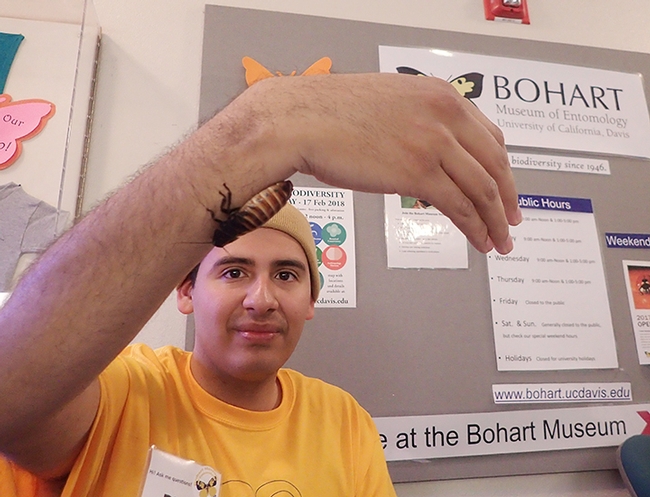

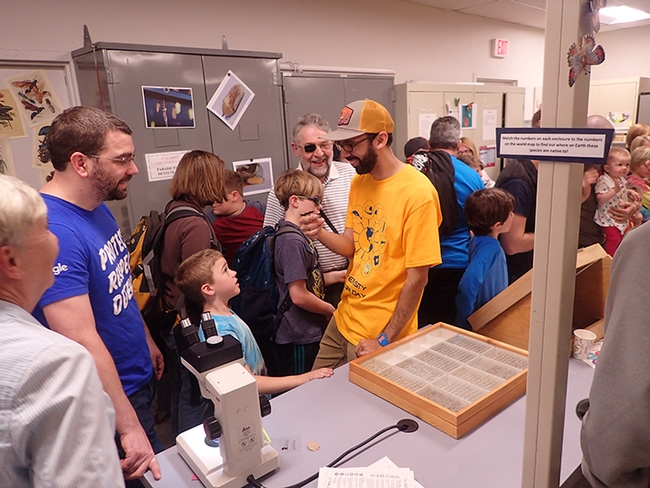
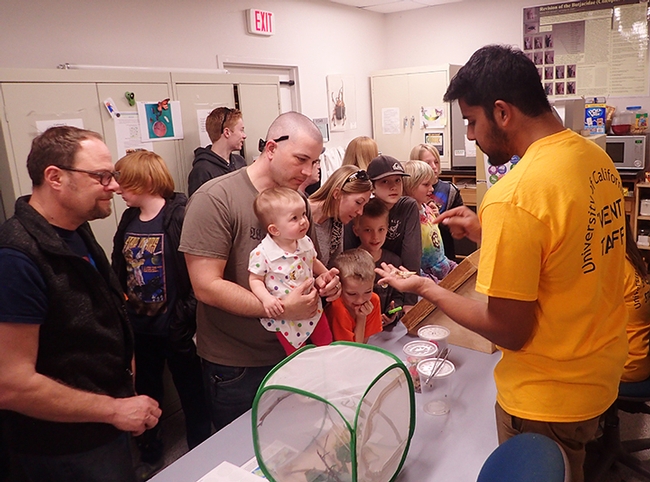
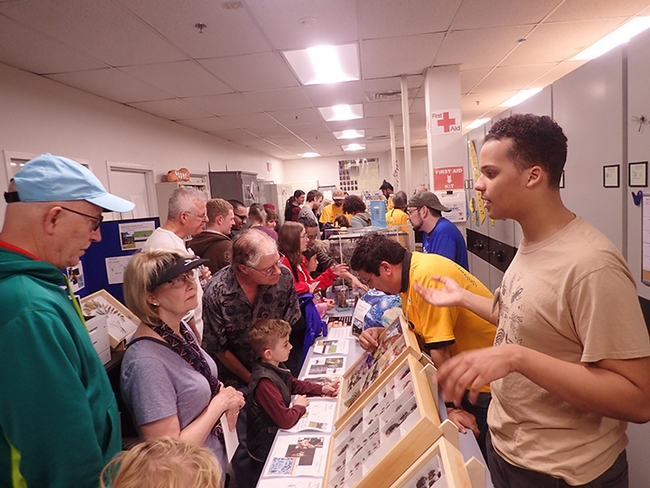
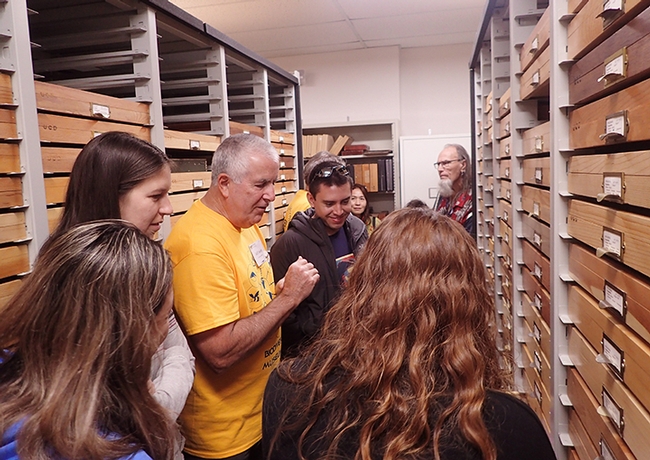
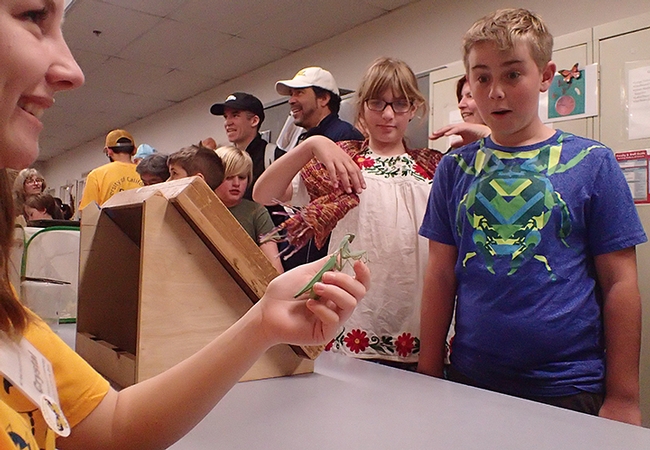
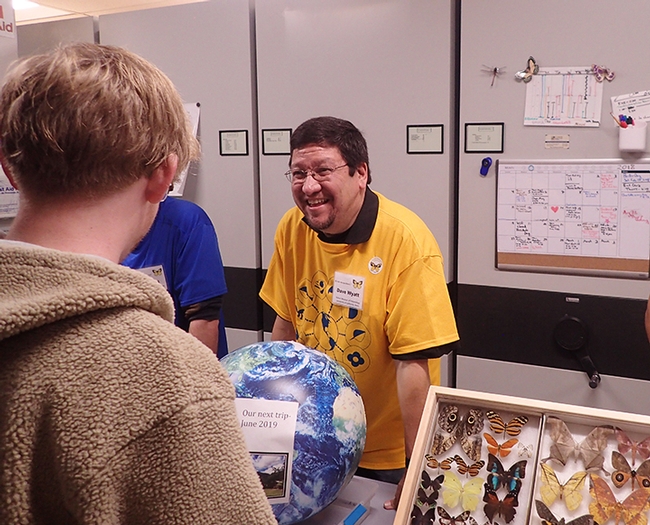
- Author: Kathy Keatley Garvey
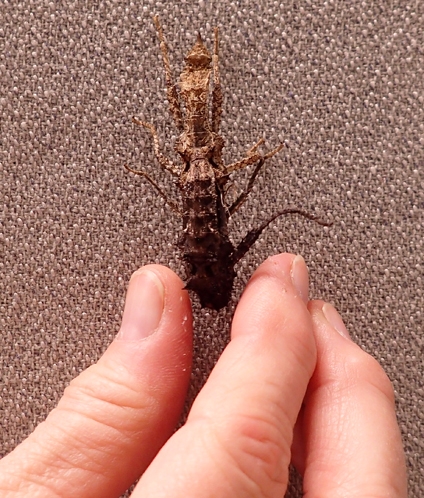
It walked.
When Lynn Kimsey, director of the Bohart Museum of Entomology and UC Davis professor of entomology, glanced at a wall near the entrance of the Bohart Museum during a recent open house, she noticed something that wasn't part of the wall.
A stick insect, aka walking stick.
An escapee from the Bohart's live "petting zoo."
And it was doing what stick insects (Phasmatodea) do--it was molting.
“It should be finished by now,” Kimsey said, periodically keeping an eye on its progress.
"Twiggy" is now back in the petting zoo, awaiting the arrival of visitors to the Bohart Museum during the seventh annual UC Davis Biodiversity Museum Day from 9 a.m. to 4 p.m. on Saturday, Feb. 17, when the public can explore the diversity of life at 13 museums and/or collections. For free. Times will vary from 9 a.m. to 1 p.m. or from noon to 4 p.m. The Bohart, located in Room 1124 of the Academic Surge Building on Crocker Lane and the home of nearly eight million insect specimens, will be open from 9 a.m. to 1 p.m. (See more information on Biodiversity Day.)
Like all insects, stick insects have a head, thorax and abdomen and six legs. Their elongated bodies mimic a stick or straw. These "bug sticks" don't move fast (is that why they're calling "walking sticks" instead of "running sticks?"), but what a perfect camouflage from predators!
Entomologists tell us that before reaching the adult stage, a stick insect may shed its skin six to nine times, depending on the species and the gender. Its outer skeleton (skin) prevents it from growing so it sheds its skin to do so.
Stick insects are a favorite at the Bohart Museum petting zoo, which also includes Madagascar hissing cockroaches, praying mantises, and tarantulas. Visitors love to hold the sticks and photograph them. They can also purchase stick insect T-shirts in the Bohart Museum's year-around gift shop.
Ever see a stick insect molting? Here's a You Tube channel that depicts the process perfectly. You can also learn about them in this Fascinating Facts About Stick Insects.
A few facts from Wikipedia:
- The genus Phobaeticus includes the world's longest insects and can reach 12 inches long.
- Many species have a secondary line of defense in the form of startle displays, spines or toxic secretions
- Phasmatodea can be found all over the world except for the Antarctic and Patagonia.
- They are most numerous in the tropics and subtropics; the greatest diversity is found in Southeast Asia and South America, followed by Australia, Central America, and the southern United States.
- The island of Borneo has more species of Phasmatodea than any other place in the world: The count: 300 species.
- Many species of phasmids are parthenogenic, meaning the females lay eggs without needing to mate with males to produce offspring.
